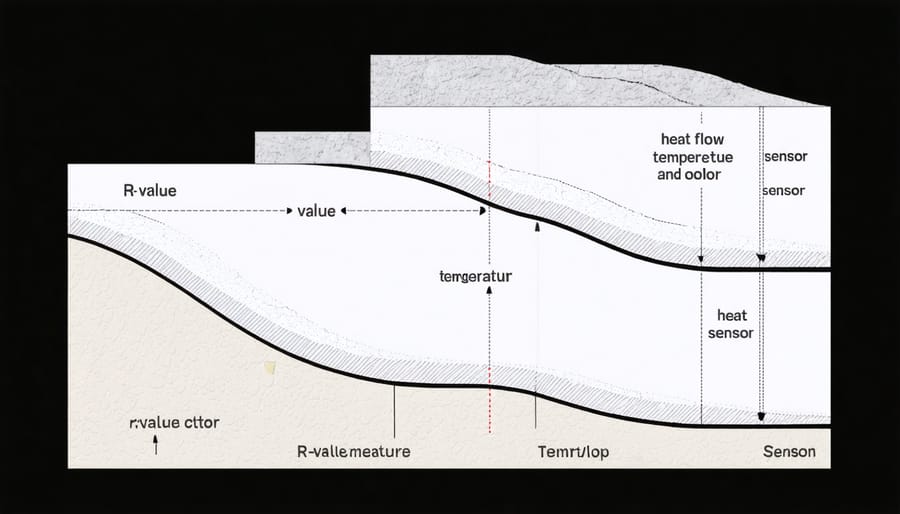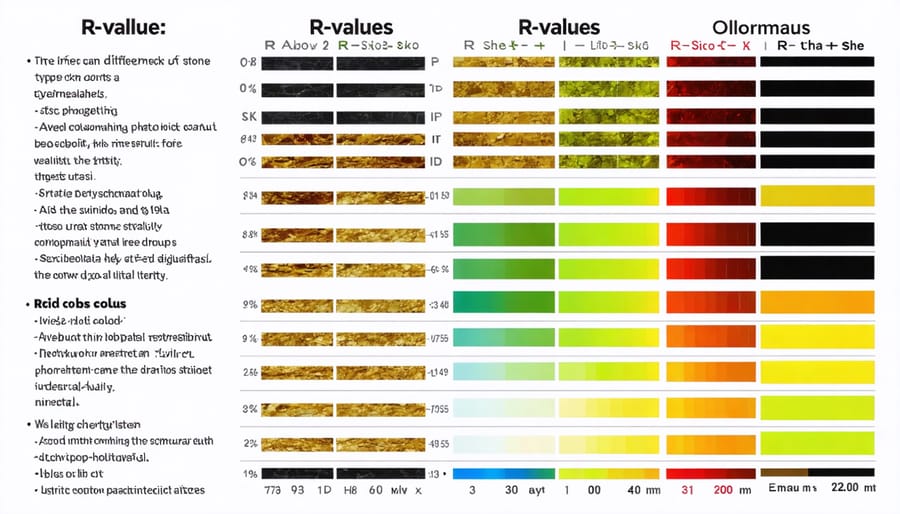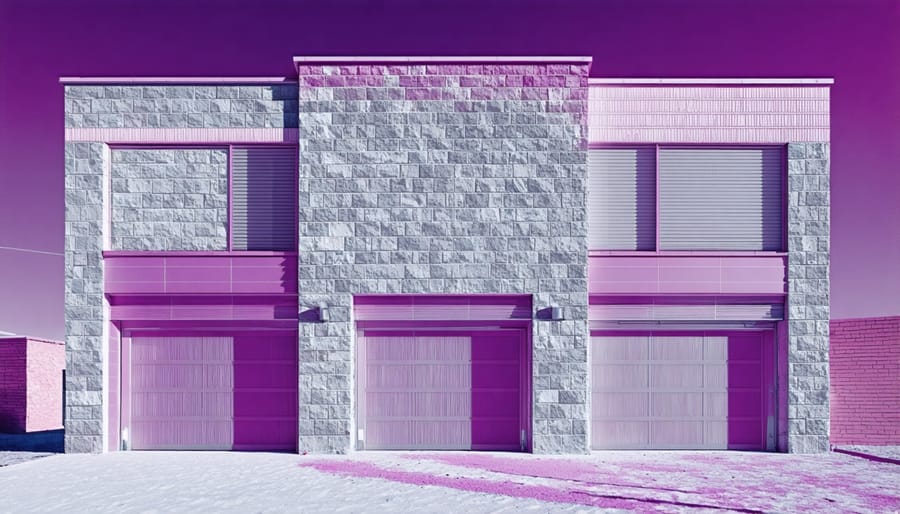Understanding the r-value of stone is crucial for maximizing energy efficiency and managing construction costs in modern building projects. Natural stone, while renowned for its durability and aesthetic appeal, typically offers r-values ranging from 0.05 to 0.8 per inch thickness, significantly lower than contemporary insulation materials. This thermal resistance property directly impacts a building’s energy performance and long-term operating expenses. Climate-conscious architects and builders now leverage stone’s thermal mass properties alongside supplementary insulation systems to create energy-efficient structures that maintain historical authenticity. By understanding these fundamental characteristics, project planners can make informed decisions about stone selection, placement, and supplementary insulation requirements to achieve optimal thermal performance while preserving the timeless appeal of natural stone construction.
Understanding R-Value in Natural Stone
What R-Value Really Means
R-value measures a material’s thermal resistance, or its ability to resist heat flow. The higher the R-value, the better the material performs as an insulator. When discussing stone, R-value helps us understand how effectively it prevents heat transfer between the interior and exterior of a building.
Think of R-value as a barrier’s strength against temperature change. For example, a one-inch thick piece of granite typically has an R-value of around 0.05, while marble might range between 0.08 and 0.12. While these numbers may seem low compared to traditional insulation materials, stone offers unique benefits through its thermal mass properties.
Thermal mass allows stone to absorb and store heat during warm periods and release it when temperatures drop. This characteristic, while not directly reflected in R-value measurements, plays a crucial role in maintaining comfortable indoor temperatures and reducing energy costs over time. Understanding both R-value and thermal mass is essential for making informed decisions about stone applications in construction projects.
How R-Value is Measured in Stone
R-value measurement in stone follows standardized testing procedures established by ASTM International. The most common method uses a heat flow meter apparatus, which measures thermal conductivity by applying controlled temperature differentials across stone samples. Test specimens are typically cut to specific dimensions and conditioned to a standard temperature and humidity before testing.
The process involves placing the stone sample between hot and cold plates in the testing apparatus. Sensors measure the heat flow through the material over time, accounting for thickness and temperature difference. The resulting data is used to calculate the stone’s thermal resistance (R-value) per inch of thickness.
Different laboratories may use either the guarded hot plate method (ASTM C177) or heat flow meter method (ASTM C518). These tests are conducted under strict environmental controls to ensure accuracy and repeatability. Results can vary slightly between testing facilities, so it’s important to reference standardized test conditions when comparing R-values from different sources.


R-Values of Common Stone Types
Marble R-Values
Marble typically has an R-value ranging from 0.08 to 0.12 per inch thickness, making it a relatively poor insulator compared to modern building materials. However, its thermal mass properties can help regulate indoor temperatures in certain climates. Premium white Carrara marble tends to have slightly higher R-values than darker varieties, but the difference is minimal from an insulation perspective. While marble’s insulation properties aren’t impressive, its durability and aesthetic value often justify its higher cost, which can range from $40 to $200 per square foot installed. When using marble in construction, additional insulation materials are typically required to meet building energy codes, adding to the overall project cost.
Granite R-Values
Granite typically has an R-value ranging from 0.05 to 0.08 per inch of thickness, making it a relatively poor insulator when compared to conventional building insulation materials. However, its thermal mass properties can help regulate indoor temperatures, potentially reducing heating and cooling costs over time. A standard 1.25-inch granite countertop or wall cladding provides minimal insulation value, but its durability and aesthetic appeal often justify the investment. When used in exterior applications, granite should be paired with proper insulation materials to meet building energy codes. While the initial cost of granite can be substantial ($40-100 per square foot installed), its long-term energy performance should be considered alongside its timeless beauty and exceptional durability.
Limestone R-Values
Limestone typically offers an R-value ranging from 0.08 to 0.11 per inch of thickness, making it a moderate thermal insulator among natural stones. A standard 4-inch limestone wall provides an R-value of approximately 0.32 to 0.44. While these values might seem low compared to conventional insulation materials, limestone’s thermal mass properties help regulate indoor temperatures naturally, potentially reducing heating and cooling costs over time. The cost implications of using limestone for insulation purposes vary, with prices ranging from $8 to $15 per square foot installed. When considering limestone for its insulative properties, it’s important to factor in additional insulation materials to meet modern building codes and energy efficiency standards.
Slate R-Values
Slate typically offers an R-value ranging from 0.05 to 0.11 per inch thickness, making it a relatively poor insulator when used alone. However, its durability and longevity often justify the additional costs of supplementary insulation. A standard slate roof installation costs between $15-25 per square foot, with the added insulation requirements increasing the total project cost by approximately 15-20%. While the initial investment is higher, slate’s exceptional lifespan of 75-100 years and its ability to maintain consistent indoor temperatures when properly insulated make it a cost-effective choice for long-term applications. For optimal thermal performance, professionals recommend combining slate with high-performance insulation materials to achieve the desired R-value for your climate zone.
Cost Analysis: R-Value Impact
Initial Investment vs. Energy Savings
When considering stone materials with higher R-values, the initial investment often appears substantial compared to alternatives with lower insulation properties. However, analyzing the investment returns on natural stone reveals significant long-term benefits through energy savings.
A typical premium for stones with superior R-values might range from 15-30% above standard options, but this cost difference can be recovered through reduced heating and cooling expenses. For example, a residential project using high R-value granite instead of standard limestone might cost an additional $5,000 upfront but save $300-500 annually in energy costs.
The payback period varies depending on climate conditions, energy prices, and the specific stone chosen. In colder regions, homeowners typically see returns within 8-12 years, while those in moderate climates might require 12-15 years to break even. Beyond monetary savings, higher R-value stones provide consistent indoor temperatures and reduced HVAC strain.
When evaluating cost-effectiveness, consider:
– Local climate severity
– Current energy rates
– Building orientation
– Wall assembly design
– Expected property ownership duration
These factors help determine whether the premium paid for better-insulating stone materials aligns with your long-term financial goals and comfort requirements.

Climate Considerations
The importance of stone’s r-value varies significantly depending on your local climate conditions. In cold regions like the Northeast United States or Canada, higher r-values become crucial for maintaining indoor temperatures and reducing heating costs. Stone walls with poor insulation properties can lead to substantial heat loss during winter months, potentially increasing energy bills by 20-30%.
Conversely, in hot climates like the Southwest, stone’s thermal mass properties might be more beneficial than its r-value alone. Dense stones can absorb heat during the day and release it at night, creating a natural cooling effect. However, proper insulation remains important to prevent unwanted heat gain during peak temperatures.
Coastal areas present unique challenges due to high humidity and salt exposure. While r-value remains important, moisture resistance and durability often take precedence in stone selection. In temperate climates with moderate temperature swings, a balanced approach to stone selection might focus on both insulation and thermal mass properties.
Climate considerations should also account for extreme weather events and seasonal variations. Stone with adequate r-value can help maintain consistent indoor temperatures during unexpected weather patterns and reduce the strain on HVAC systems. For optimal performance, consider combining stone with supplementary insulation materials that complement your specific climate challenges.
Maximizing Stone R-Value Performance
To maximize stone’s insulation performance, proper installation and complementary materials are essential. Start by ensuring a continuous air barrier behind the stone veneer, as air infiltration can significantly reduce thermal efficiency. Install a high-quality vapor barrier to prevent moisture issues that could compromise insulation effectiveness.
Consider incorporating an insulation layer between the stone and substrate. Rigid foam insulation or mineral wool boards can dramatically improve the overall R-value of the wall assembly. Pay special attention to joints and seams, using appropriate sealants to prevent thermal bridges.
The thickness of stone material matters – generally, thicker stones provide better insulation. However, balance this with practical considerations like weight and cost. For optimal performance, combine natural stone with modern insulation techniques such as cavity walls or thermally broken anchoring systems.
Climate-specific considerations are crucial. In hot climates, lighter-colored stones reflect more solar radiation, while darker stones in cold climates can help with passive solar heating. Strategic placement of stone elements can also enhance thermal performance – for example, using thermal mass principles to store heat during the day and release it at night.
Regular maintenance ensures long-term insulation effectiveness. Inspect and repair any damaged joints or sealants promptly, and keep weep holes clear to prevent moisture accumulation. Consider periodic thermal imaging assessments to identify any insulation weak points in your stone installation.
Understanding the r-value of stone is crucial for making informed decisions in construction and design projects. While natural stone typically offers lower r-values compared to modern insulation materials, its durability, aesthetic appeal, and thermal mass properties make it a valuable building material. When selecting stone for your project, consider both the initial costs and long-term energy implications. Higher r-value stones may cost more upfront but can contribute to energy savings over time. The key is striking the right balance between insulation needs, budget constraints, and design goals. Remember that stone can be effectively combined with additional insulation materials to achieve optimal thermal performance while maintaining the desired architectural aesthetic and structural integrity.










